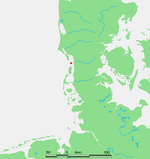Wadden Sea Centre
Esbjerg MunicipalityMuseums in the Region of Southern DenmarkNature centers in Denmark

The Wadden Sea Centre (Danish: Vadehavscentret) is a visitor centre and museum for the UNESCO World Heritage Site the Wadden Sea, an intertidal zone of the North Sea. The centre is located in Vester Vedsted, near Ribe, Denmark, and opened in February 2017. It serves to raise awareness of the Wadden Sea and the marshlands around it.
Excerpt from the Wikipedia article Wadden Sea Centre (License: CC BY-SA 3.0, Authors, Images).Wadden Sea Centre
Mandøvej, Esbjerg Municipality
Geographical coordinates (GPS) Address Website External links Nearby Places Show on map
Geographical coordinates (GPS)
| Latitude | Longitude |
|---|---|
| N 55.295555555556 ° | E 8.6691666666667 ° |
Address
Vadehavscentret
Mandøvej
Esbjerg Municipality
Region of Southern Denmark, Denmark
Open on Google Maps









